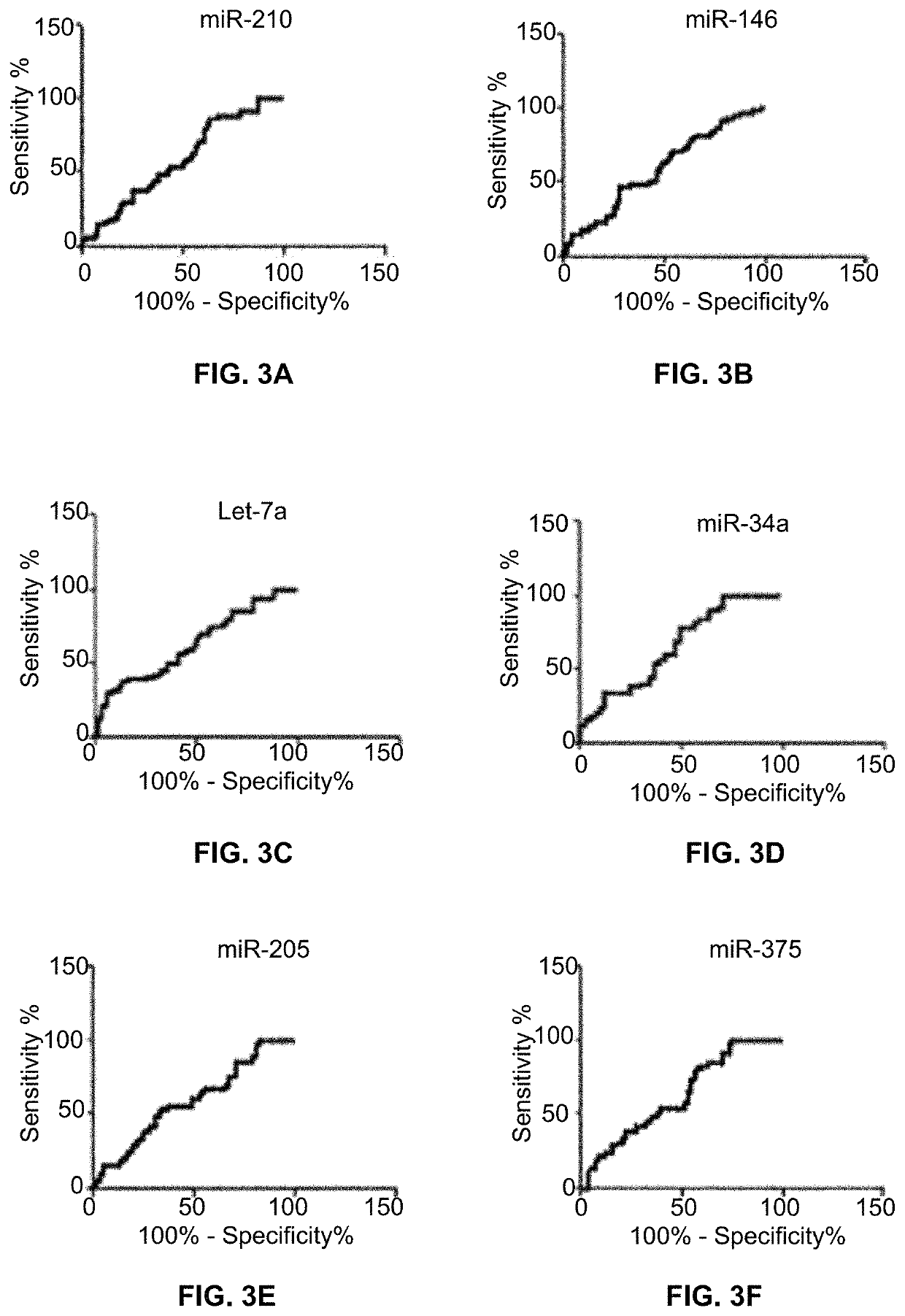Biomarkers for diagnosis and prognosis of lung cancer
a biomarker and lung cancer technology, applied in the field of lung cancer biology, can solve the problems of high cost of multiple follow-up examinations, poor sensitivity of sputum cytology for lung cancer detection, and low specificity of blood-based biomarkers for lung cancer early detection and diagnosis
- Summary
- Abstract
- Description
- Claims
- Application Information
AI Technical Summary
Benefits of technology
Problems solved by technology
Method used
Image
Examples
example 1
Methods and Materials
Patient Cohorts
[0043]The protocol was approved by the Institutional Review Boards of the Baltimore VA Medical Center and the University of Maryland Medical Center. Consent was obtained from lung cancer patients and control subjects in the Medical Centers. Final diagnoses for lung cancer were confirmed by using histopathologic examinations of biopsy and surgical tissue specimens. Computer tomography (CT) imaging was performed using a standard clinical protocol. Two board-certified radiologists independently read the CT imaging. A positive result from the CT image was determined according to the Fleischner Society-guidelines for management of small pulmonary nodules detected on CT scans (21-23). The surgical pathologic staging was determined according to the TNM classification of the International Union Against Cancer with the American Joint Committee on Cancer and the International Staging System for Lung Cancer. Histopathologic classification was determined acco...
example 2
Analysis of Genes in Sputum from Lung Cancer Patients
[0048]Sputum was obtained from 92 lung cancer patients and 81 smokers with benign pulmonary nodules. Demographic and clinical information is shown in Table 1.
[0049]
TABLE 1Demographic and clinical information of cancer patientsVariableCancerBenignp-valueAge (year)25-8341-8125-83Mean60.1863.9555.91SD12.048.9613.6sRace0.2715White834835AA894445Native Indian101Gender0.5116Male1307159Female432122Smoking package / year0-2500-2500-75Mean35.6551.3817.79SD36.6039.2022.91CT diagnosisCancer69636Non-cancer1042975Final diagnosisSCLC18NSCLC70other4StageI1Ib = 1.53II = 23IIb = 2.52IIIa = 39IIIb = 3.514IV = 429missing31
49 genes were found in the sputum samples and analyzed for changes. Changes in 23 genes are associated with lung cancer (Table 2).
[0050]
TABLE 2Genes in sputum associated with lung cancerPearson'sEstimatedGeneCoefficientp-valueAUCM16-7a0.2080.01000.623M16-310.1670.03570.605M16-1260.4780.775M16-4860.4860.786M16-6520.1770.04230615sno61-m...
example 3
Sputum miRNAs can Discriminate Between NSCLC Lung Cancer Patients and Controls
[0053]ROC curve analysis was applied to evaluate the capacity of using each of miR-210 (FIG. 3A), miR-146 (FIG. 3B), Let-7a (FIG. 3C), miR-34a (FIG. 3D), miR-205 (FIG. 3E), miR-375 (FIG. 3F), miR-31 (FIG. 3G), miR-652 (FIG. 3H), miR-21 (FIG. 3I), miR-126 (FIG. 3J) and miR-486-5p (FIG. 3K) for discriminating lung cancer patients from controls. The individual miRNAS exhibit AUC values of 0.609-0.786 in distinguishing non-small cell lung cancer (NSCLC) cancer cases from controls. Table 3 identifies seven of these miRNAs whose expressions in sputum are associated with a stage of NSCLC.
[0054]
TABLE 3Genes in sputum associated with NSCLCmiRNAsPearson's coefficientp-valuemiR-146a0.3460.0103miR-6520.4080.0080miR-34a0.4610.0018miR-310.3710.0067Let-7a0.2960.0314miR-2050.3010.0231miR-2100.2700.0385
PUM
| Property | Measurement | Unit |
|---|---|---|
| size | aaaaa | aaaaa |
| low-dose computed tomography | aaaaa | aaaaa |
| length | aaaaa | aaaaa |
Abstract
Description
Claims
Application Information
 Login to View More
Login to View More - R&D
- Intellectual Property
- Life Sciences
- Materials
- Tech Scout
- Unparalleled Data Quality
- Higher Quality Content
- 60% Fewer Hallucinations
Browse by: Latest US Patents, China's latest patents, Technical Efficacy Thesaurus, Application Domain, Technology Topic, Popular Technical Reports.
© 2025 PatSnap. All rights reserved.Legal|Privacy policy|Modern Slavery Act Transparency Statement|Sitemap|About US| Contact US: help@patsnap.com



